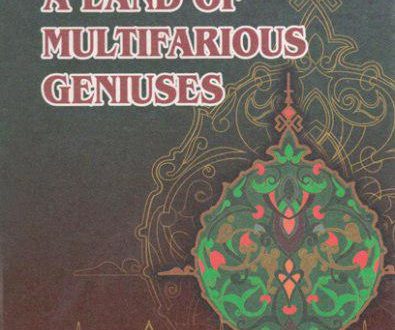A number of scholars and enlighteners were educated in Kho-resm under the positive influence of the scientific and spiritual heritage left by an estimated scholar His Excellency az-Zamakhshari. One of them was Abu-l-Fathal-Mutarrizi. Information about him can be found in the works of the following authors:
- Yaqut al-Hamavi;
- Zayniddin Qasim ibn Qutlubugha;
- Ibn al-Qifti;
- Ibn Khallikan;
- Al-Kafavi;
- Abdulhay al-Laknavi;
- Hajji Khalifa and others.
Relying on the statements of the above-mentioned authors,we can say that his full name was Burhaniddin Nasir ibn Abul Makarim Abdusayyid ibn Ali Abu-l-Fath al-Mutarrizi. He was bom in 1144 (i.e. in the same year of az-Zamakhshari’s death) in Jurjania (modem Kuhna Urgench). It is perhaps, because of his full and perfect knowledge in different fields of science and high scientific potential that he earned the honourable title “Khalifat az-Zamakhshari’ (az-Zamakhshari’s successor) and was famous with this respectable title. Moreover, like az-Zamakhshari, Abu-l-Fath al-Mutarrizi was also very keen on the theory and teachings promoted by the Mu’tazilah trend in Islam and made a noticeable contribution to spreading the teachings of this trend. Therefore, he was also known as “raas al-Mu’tazilah” (a leader of the Mu’tazilis). It should be taken into consideration that though they were the supporters of the Mu’tazilah trend, in their faith they were in the Hanafian order founded by Imam A’zam. This opinion may have its proof in the book “Mu’jam al-udaba” (The encyclopaedia of literary men) written by Yaqut al-Hamavi (died in 1229, i.e. fifteen years later than Abu-l-Fath al-Mutarrizi’s death). This book consists of 7 volumes including 220 pages and contains very valuable information about Abu-l-Fath al-Mutarrizi. About his religious faithfulness, the author writes the following lines: “Though Abu-l-Fath al-Mutarrizi was considered to be the leader of the Mu’tazilah trend, he belonged to the Hanafian order of Islam in his belief and faith”.
Abu-l-Fath al-Mutarrizi was born in a highly educated family. His father Abussayyid was one of the estimated and learned people of his time, and therefore Abu-l-Fath al-Mutarrizi received the primary education from his father. Later he continued his education in different branches of knowledge under the control of well-known scholars who lived and worked in Khoresm at that time. They were all the students and followers of az-Zamakhshari. He studied law, hadiths, linguistics, lexicography, literature, etc., reached the highest level of knowledge in these fields and grew up a well-known scholar of his time.
In 1204, i.e. at the age of sixty, Abu-l-Fath al-Mutarrizi decided to make a pilgrimage (hajj) to Holy Mecca. On the way to Mecca, he stayed in Baghdad where he had heated discussions with the leading scholars of this city and took an active part in the debates held among the leading experts of different fields of science. In 1213, he died in Khoresm.
Abu-l-Fath al-Mutarrizi created about ten original works on the Arabic language, its grammar, literature and lexicography some titles of which are included the following list:
- “Al-Iyzah”, a commentary written on the writings of the Arabian author al-Hariri;
- “Al-Iqna’ fi-l-lugha”, a book dealing with the problems of lexicography;
- “Al-Muqaddima fi-n-nahvi” devoted to the problems of morphology and syntax of the Arabic language;
4) “Al-Misbah fi-n-nahvi”, also devoted to the Arabian Grammar;
- “Mukhtasar “Islah al-mantiq” li ibn as-Sakkiyt”, a perfect work devoted to the commentaries of “Islah al-mantiq” by ibn Sakkiyt;
- “Al-Mughrib” (An interesting book) devoted to the problems of lexicography.
It is doubtless that Abu-l-Fath al-Mutarrizi’s book “Al-Mughrib” served as a precious source in describing and depicting the essence and meanings of the legal terms used in the sources dealing with the Hanafian law. Therefore an Arabian scholar ibn Khallikan wrote the following lines about the importance of this book: “How precious the dictionary compiled by Abu Mansur al-Azhari may be for the representatives of the Shafi’i order, Abu-l-Fath al-Mutarrizi’s dictionary is of the same importance and appreciation for the representatives of the Hanafian order”.
As is seen from the preface of the book, the author first planned to title his book as “Al-Mughrib” (Rules of reading and spelling) but later he decided to give the legal terms in the alphabetical order and re-titled his book as “Al-Mughrib fi tartib al-mu’rib” (An interesting book on reading and spelling the legal terms correctly).
As has been mentioned above, this book became famous and appreciated among the lawyers and students of law schools with a shortened title “Al-Mughrib”. In most of the sources of the Middle Ages, it is mentioned even as “Sahib al-Mughrib” (the author of “Al-Mughrib”) which was widely admitted by the specialists of law. Being a precious source in law, this book was published several times. For instance, it was published by Mahmud al-Fahuri and Abdul Hamid Mukhtar in 1910 in Haidarabad (in two volumes), and in 1982 in Damascus, the capital city of Syria. In our opinion, the manuscripts of this precious source are preserved in different libraries of the world. The most important point in this matter is the fact that the most ancient and precious three copies of the manuscript are preserved in Tashkent, in the scientific library of the Institute of Oriental Studies named after Abu Rayhan Beruni. By studying and investigating these works, it will be possible to deliver the important spiritual heritage left for our generation by the scholar Abu-l-Fath al-Mutarrizi to the attention of the public and specialists.
Irgash Daminov
 Imom Buxoriy xalqaro ilmiy-tadqiqot markazi bukhari.uz
Imom Buxoriy xalqaro ilmiy-tadqiqot markazi bukhari.uz











